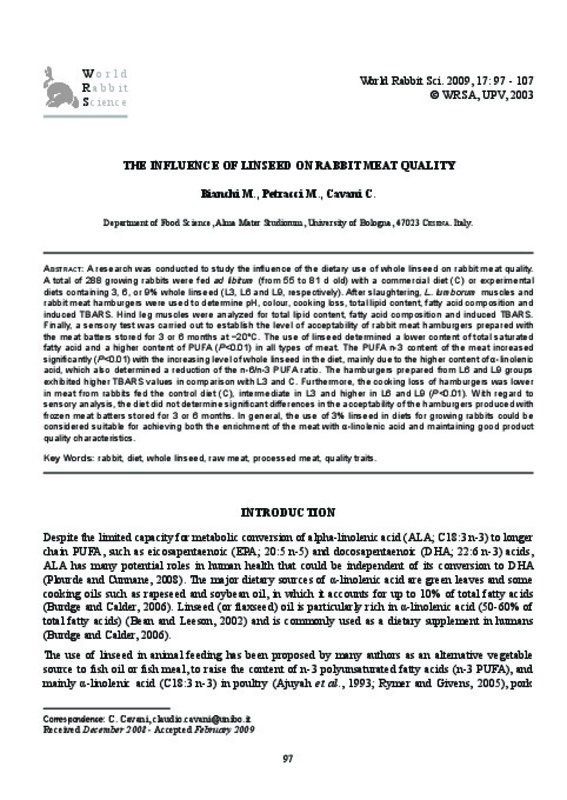JavaScript is disabled for your browser. Some features of this site may not work without it.
Buscar en RiuNet
Listar
Mi cuenta
Estadísticas
Ayuda RiuNet
Admin. UPV
The influence of linseed on rabbit meat quality
Mostrar el registro sencillo del ítem
Ficheros en el ítem
| dc.contributor.author | Bianchi, M.
|
|
| dc.contributor.author | Petracci, M.
|
|
| dc.contributor.author | Cavani, C.
|
|
| dc.date.accessioned | 2009-07-27T11:44:38Z | |
| dc.date.available | 2009-07-27T11:44:38Z | |
| dc.date.issued | 2009 | |
| dc.identifier.issn | 1257-5011 | |
| dc.identifier.uri | http://hdl.handle.net/10251/6045 | |
| dc.description.abstract | [EN] A research project was conducted to study the influence of the dietary use of whole linseed on rabbit meat quality. A total of 288 growing rabbits were fed ad libitum (from 55 to 81 d old) with a commercial diet (C) or experimental diets containing 3, 6, or 9% whole linseed (L3, L6 and L9, respectively). After slaughtering, L. lumborum muscles and rabbit meat hamburgers were used to determine pH, colour, cooking loss, total lipid content, fatty acid composition and induced TBARS. Hind leg muscles were analyzed for total lipid content, fatty acid composition and induced TBARS. Finally, a sensory test was carried out to establish the level of acceptability of rabbit meat hamburgers prepared with the meat batters stored for 3 or 6 months at -20°C. The use of linseed determined a lower content of total saturated fatty acid and a higher content of PUFA (P<0.01) in all types of meat. The PUFA n-3 content of the meat increased significantly (P<0.01) with the increasing level of whole linseed in the diet, mainly due to the higher content of alpha-linolenic acid, which also determined a reduction of the n-6/n-3 PUFA ratio. The hamburgers prepared from L6 and L9 groups exhibited higher TBARS values in comparison with L3 and C. Furthermore, the cooking loss of hamburgers was lower in meat from rabbits fed the control diet (C), intermediate in L3 and higher in L6 and L9 (P<0.01). With regard to sensory analysis, the diet did not determine significant differences in the acceptability of the hamburgers produced with frozen meat batters stored for 3 or 6 months. In general, the use of 3% linseed in diets for growing rabbits could be considered suitable for achieving both the enrichment of the meat with alpha-linolenic acid and maintaining good product quality characteristics. | en_EN |
| dc.description.sponsorship | The authors are grateful to “F.lli Martini & C. S.p.A.” for technical assistance. Research funded by MIUR - PRIN ex 40%. | |
| dc.language | Inglés | en_EN |
| dc.publisher | World Rabbit Science. ICTA. UPV | en_EN |
| dc.relation.ispartof | World Rabbit Science | |
| dc.rights | Reserva de todos los derechos | es_ES |
| dc.subject | Quality traits | en_EN |
| dc.subject | Processed meat | en_EN |
| dc.subject | Raw meat | en_EN |
| dc.subject | Whole linseed | en_EN |
| dc.subject | Diet | en_EN |
| dc.subject | Rabbit | en_EN |
| dc.title | The influence of linseed on rabbit meat quality | en_EN |
| dc.type | Artículo | en_EN |
| dc.identifier.doi | 10.4995/wrs.2009.663 | |
| dc.rights.accessRights | Abierto | es_ES |
| dc.description.bibliographicCitation | Bianchi, M.; Petracci, M.; Cavani, C. (2009). The influence of linseed on rabbit meat quality. World Rabbit Science. 17(2):97-107. https://doi.org/10.4995/wrs.2009.663 | es_ES |
| dc.relation.publisherversion | https://doi.org/10.4995/wrs.2009.663 | |
| dc.description.upvformatpinicio | 97 | |
| dc.description.upvformatpfin | 107 | |
| dc.description.volume | 17 | |
| dc.description.issue | 2 | |
| dc.identifier.eissn | 1989-8886 | es_ES |
| dc.contributor.funder | Ministero dell'Istruzione dell'Università e della Ricerca, Italia |








